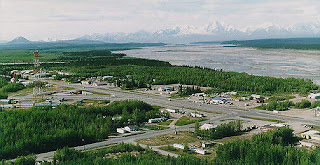The city is located a short distance south of the confluence of the Delta River with the Tanana River, which is at Big Delta. It is about 160 km (99 miles) south of Fairbanks on the Richardson Highway. Elevation is 1,158 ft. Delta Junction is the official end of the Alaska(Alcan) Highway.
Delta Junction is located at 64°2′52″N, 145°43′7″W (64.047669, -145.718655)[2].
According to the United States Census Bureau, the city has a total area of 17.3 square miles (44.7 km²), all of it land.
According to the United States Census Bureau, the city has a total area of 17.3 square miles (44.7 km²), all of it land.
"Big Delta" lies at the intersection of the Delta River and the Tanana River. The City of Delta Junction sits on the Delta River at the intersection of the Richardson Highway and the famed Alaska Highway (actually, the end of the Alaska Highway). The city and Delta community lie within the fertile Tanana River valley. Three mountain ranges -- the White Mountains to the north, the Granite Mountains to the southeast, and the Alaska Range to the southwest -- and the Delta River to the west surround the town.
Once overlain by glaciers, the geology is marked by glacial moraines as well as alluvial deposits from the Delta and Tanana Rivers. Numerous mineral deposits are found in the vicinity of Delta Junction ranging from gold to molybdenum to coal. A prominent natural feature on the landscape is Donnelly Dome, located within the Donnelly Training Area of Fort Wainwright (formerly a part of nearby Fort Greely until 2001), to the south of Delta Junction. This dome was formed as a glacier coming from the Alaska Range split in two, carving away sides of a former mountain.
As it is not near the ocean, this area is drier than coastal Alaska and experiences seasonal extremes typical of subarctic areas. The annual precipitation is only 30.5 cm (12 inches), including 94 cm (37 inches) of snow. The average low temperature in January is -23°C (-11°F).The average high during July is +20°C (+69°F). Temperature extremes have been recorded from -53°C to +33°C (-63°F to +92°F).
Delta Junction is mostly sunny in the summer and split between clear and overcast days in the winter. On clear winter nights, the aurora borealis can often be seen dancing in the sky. Like all subarctic regions, the months from May to July in the summer have no night, only a twilight during the night hours. The months of November to January have 4 to 5 daylight and twilight hours.
Delta Junction was known as the "Windy City" and "Little Chicago" by many soldiers on Fort Greely, a reference to Chicago in the lower 48 United States. In Delta Junction itself, but not in the nearby areas, wind blows many days from the south up the Delta River from the Gulf of Alaska, bringing river silt in the summer and snowdrifts in the winter. There are usually several days in the winter when the temperature is in the range of -40° (C or F) when a wind (known as a Chinook wind) begins to blow. A few minutes later, the temperature climbs to above 0°C (+32°F). When the wind stops, the temperature returns to its colder value.
Once overlain by glaciers, the geology is marked by glacial moraines as well as alluvial deposits from the Delta and Tanana Rivers. Numerous mineral deposits are found in the vicinity of Delta Junction ranging from gold to molybdenum to coal. A prominent natural feature on the landscape is Donnelly Dome, located within the Donnelly Training Area of Fort Wainwright (formerly a part of nearby Fort Greely until 2001), to the south of Delta Junction. This dome was formed as a glacier coming from the Alaska Range split in two, carving away sides of a former mountain.
As it is not near the ocean, this area is drier than coastal Alaska and experiences seasonal extremes typical of subarctic areas. The annual precipitation is only 30.5 cm (12 inches), including 94 cm (37 inches) of snow. The average low temperature in January is -23°C (-11°F).The average high during July is +20°C (+69°F). Temperature extremes have been recorded from -53°C to +33°C (-63°F to +92°F).
Delta Junction is mostly sunny in the summer and split between clear and overcast days in the winter. On clear winter nights, the aurora borealis can often be seen dancing in the sky. Like all subarctic regions, the months from May to July in the summer have no night, only a twilight during the night hours. The months of November to January have 4 to 5 daylight and twilight hours.
Delta Junction was known as the "Windy City" and "Little Chicago" by many soldiers on Fort Greely, a reference to Chicago in the lower 48 United States. In Delta Junction itself, but not in the nearby areas, wind blows many days from the south up the Delta River from the Gulf of Alaska, bringing river silt in the summer and snowdrifts in the winter. There are usually several days in the winter when the temperature is in the range of -40° (C or F) when a wind (known as a Chinook wind) begins to blow. A few minutes later, the temperature climbs to above 0°C (+32°F). When the wind stops, the temperature returns to its colder value.


0 comments:
Post a Comment